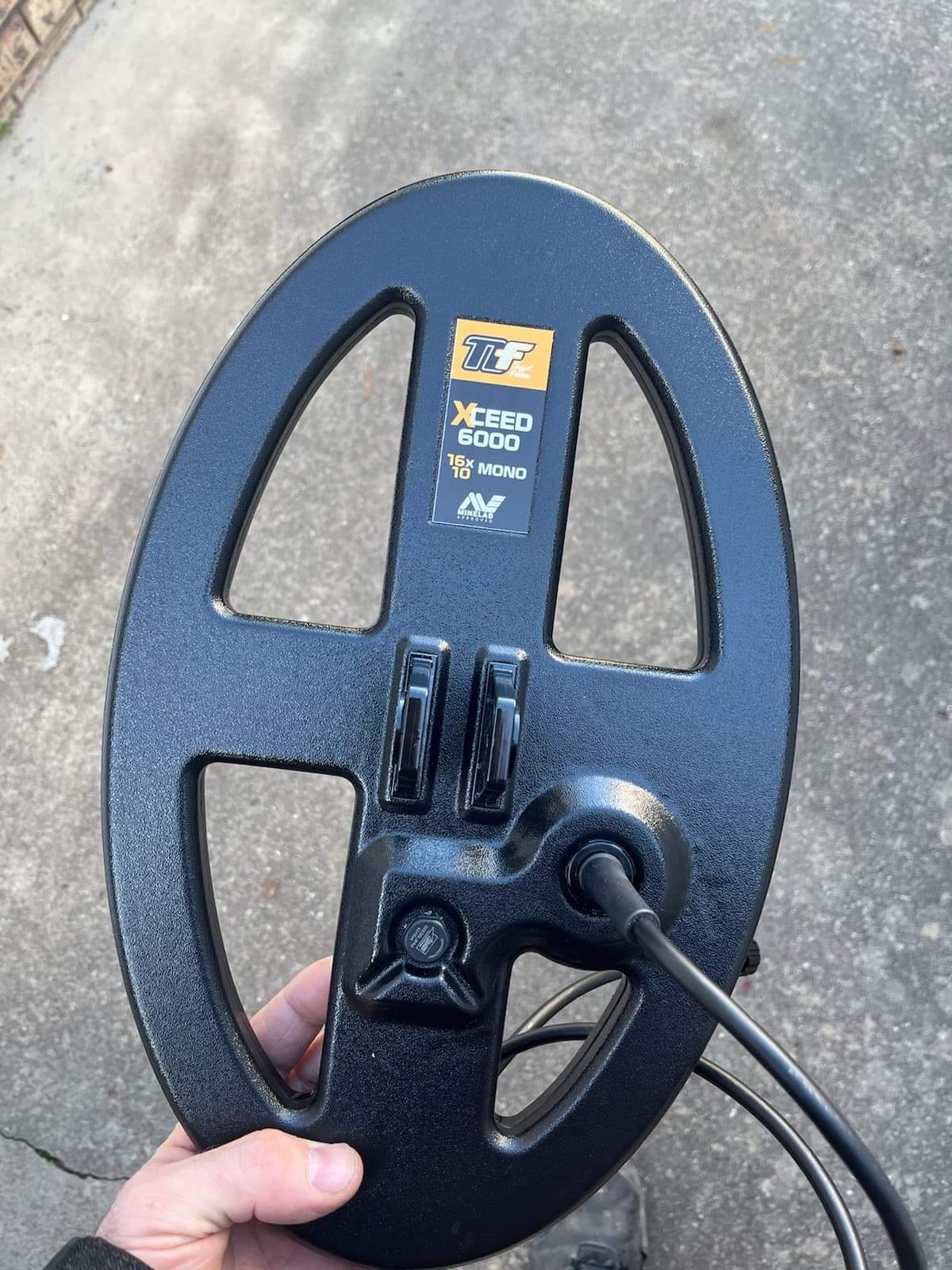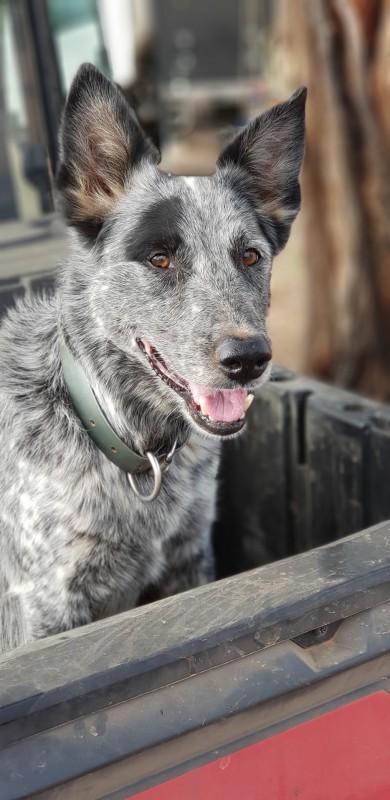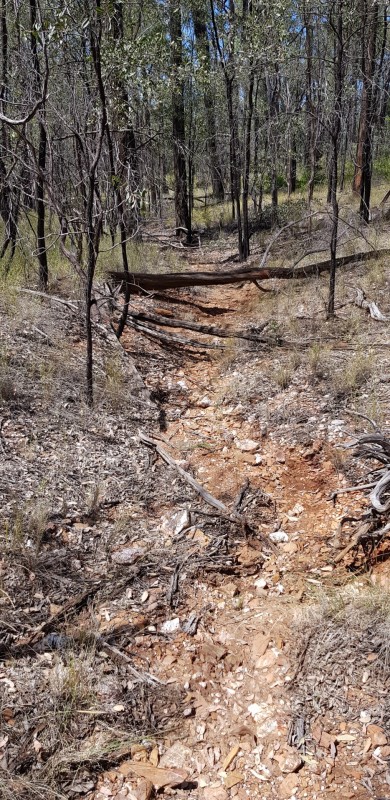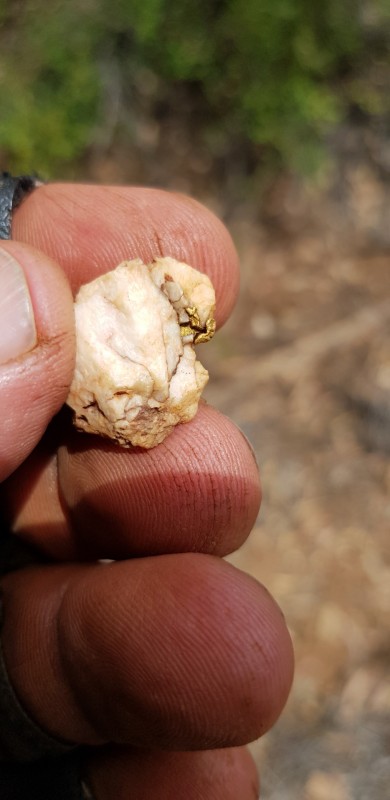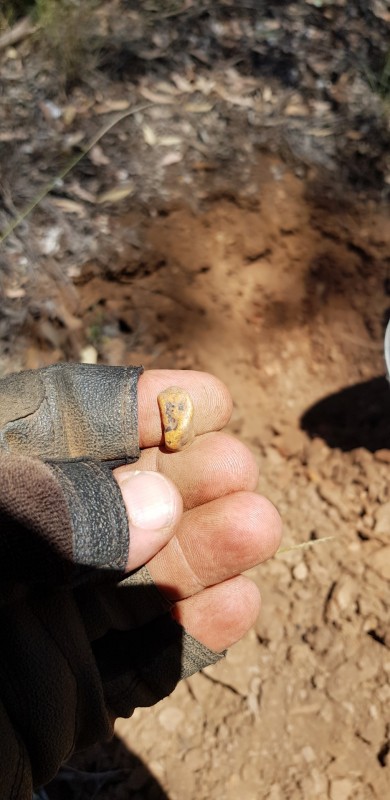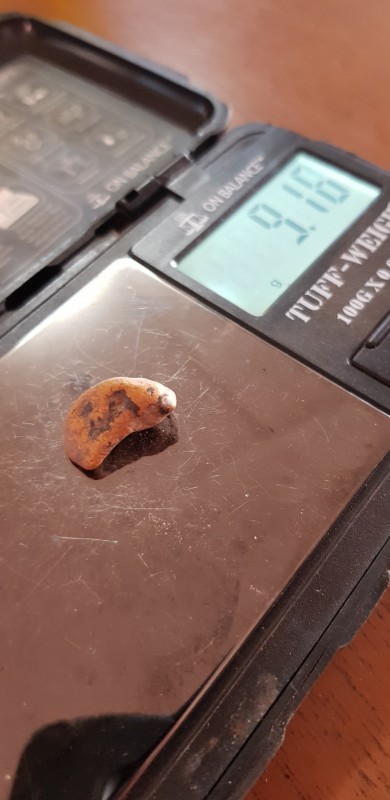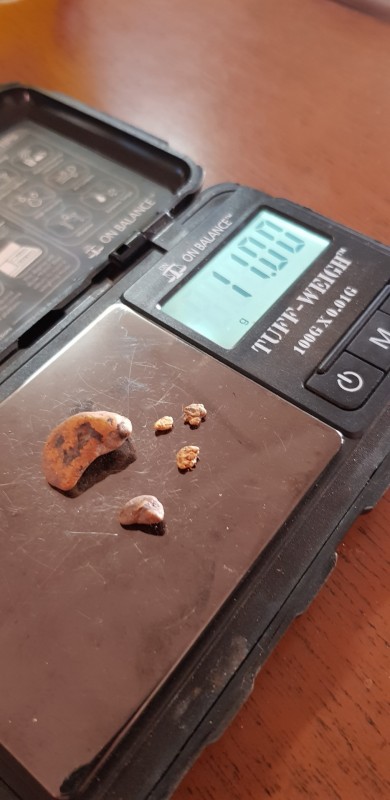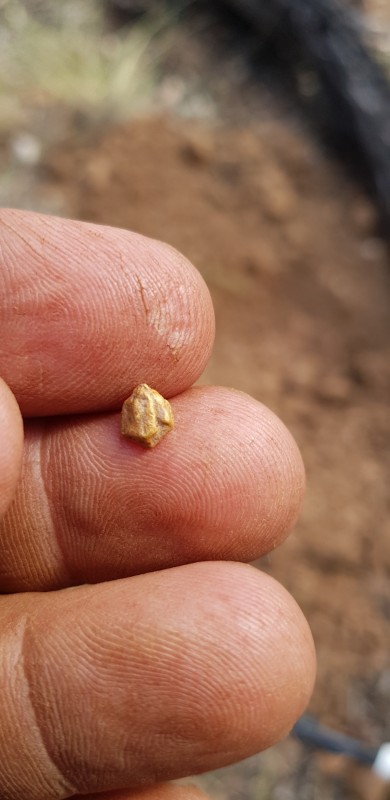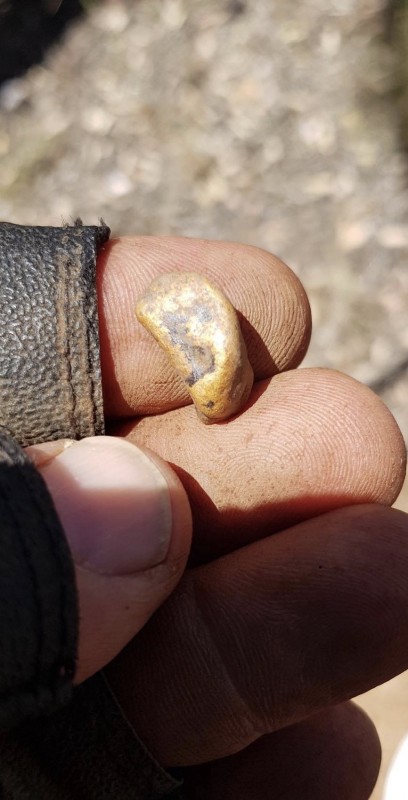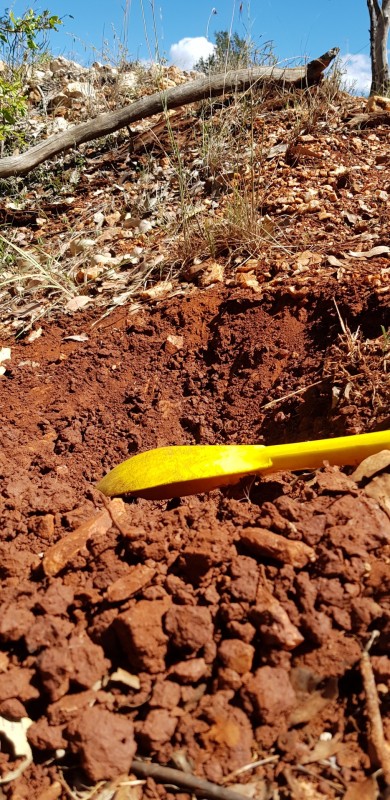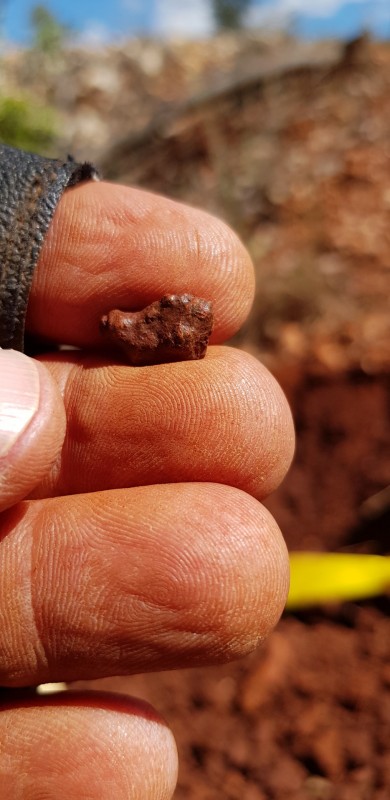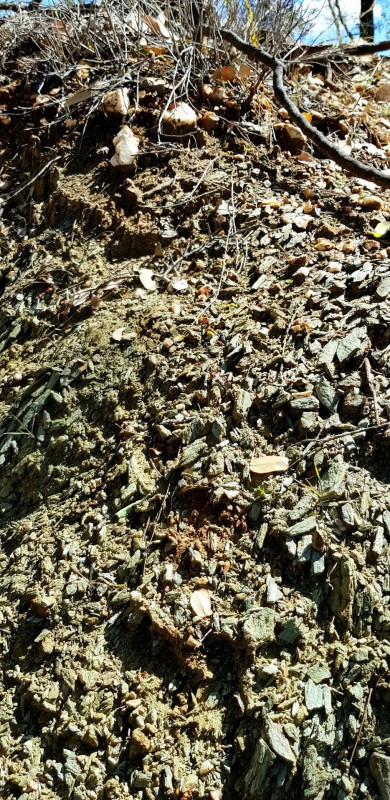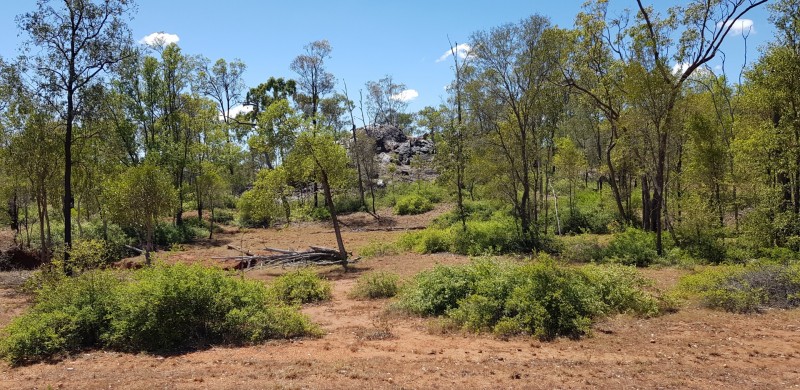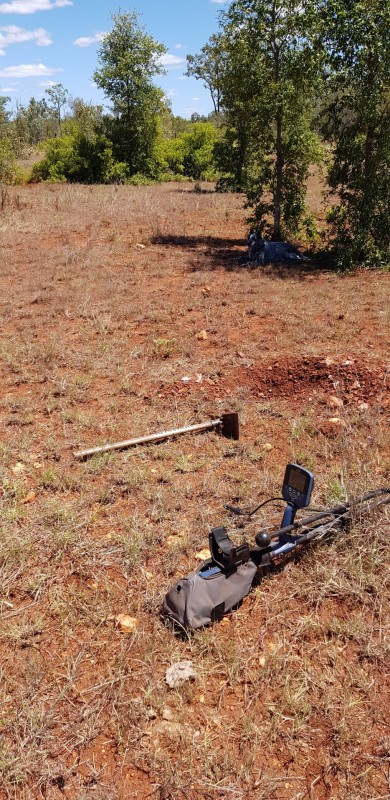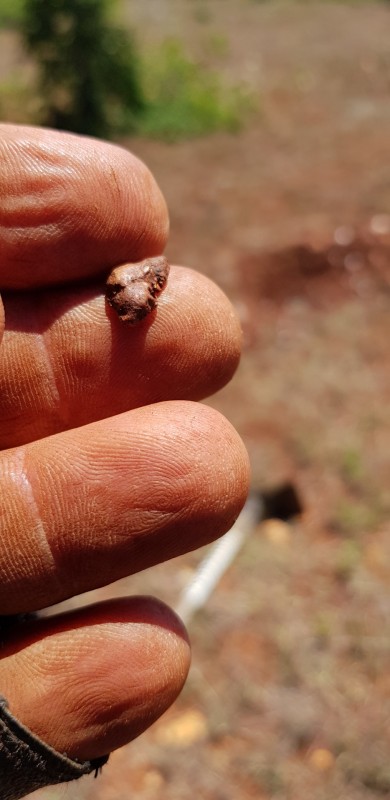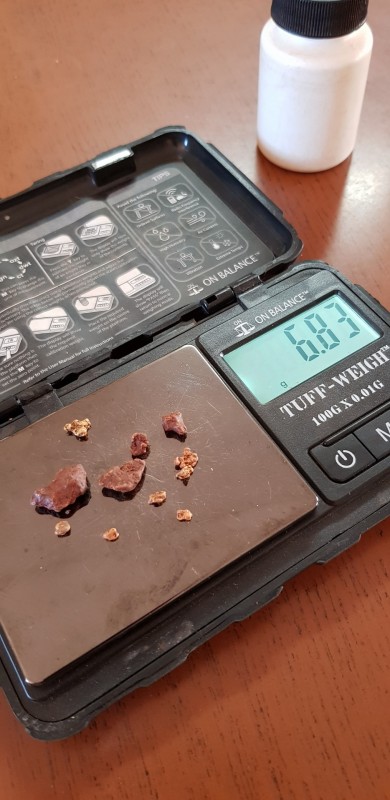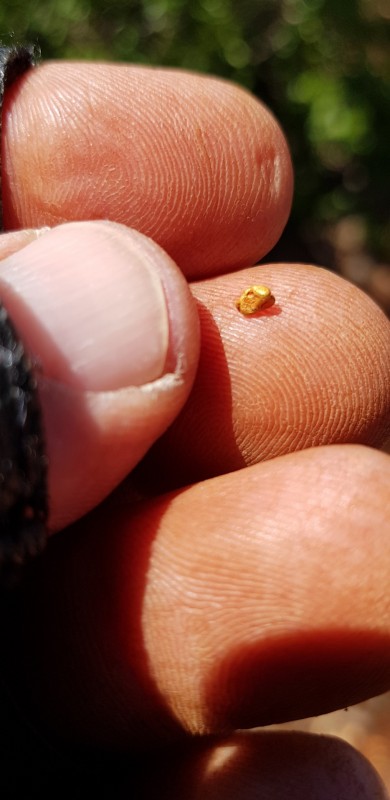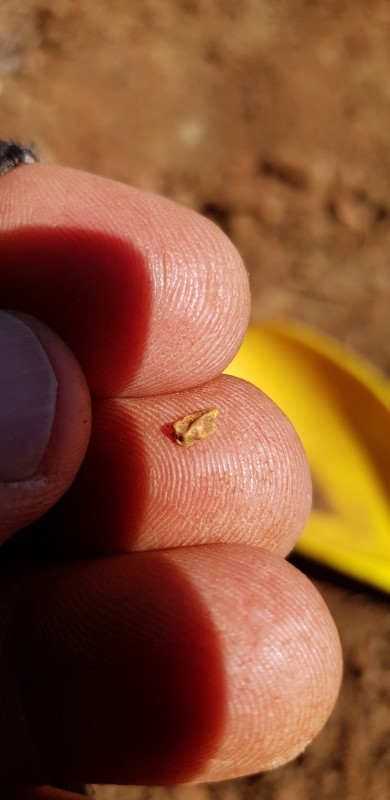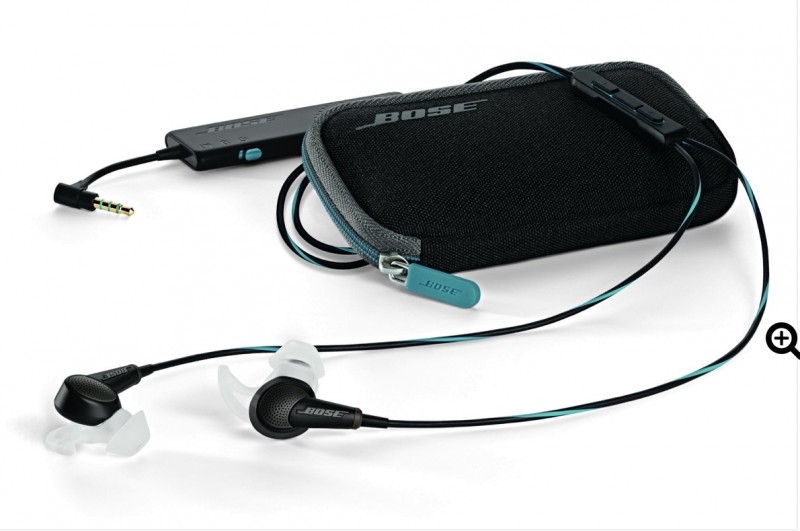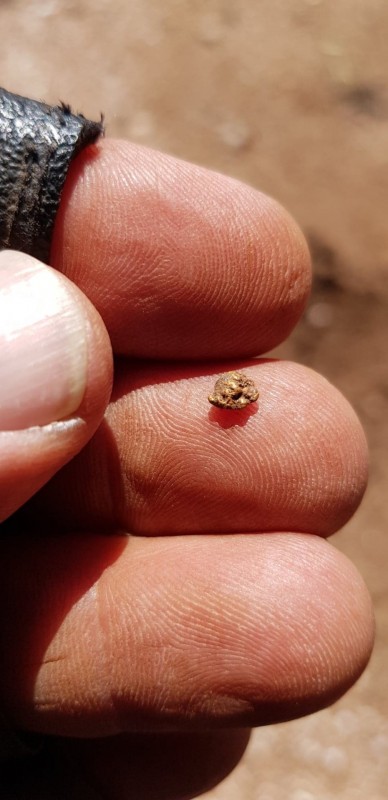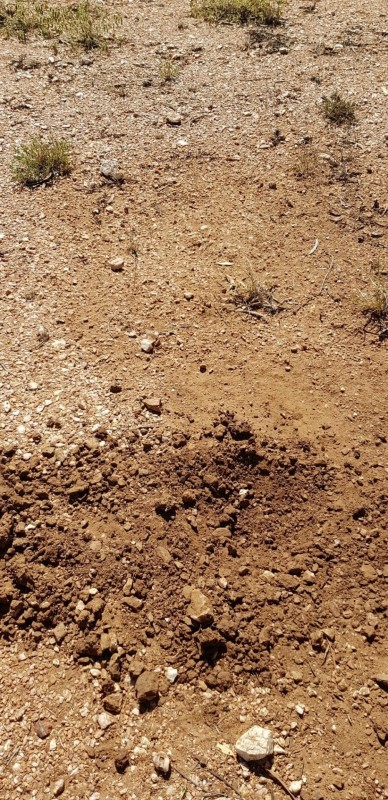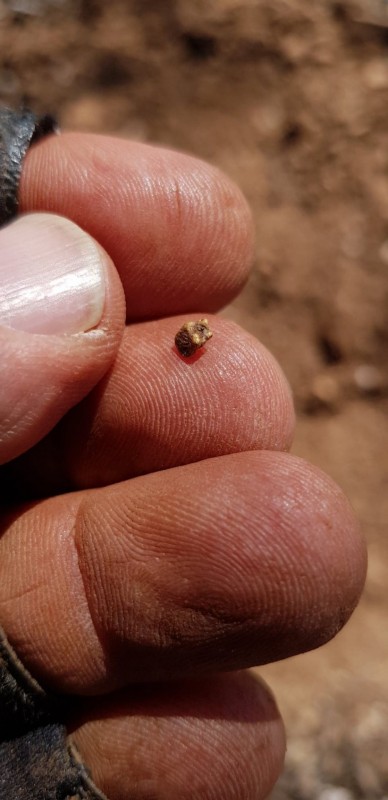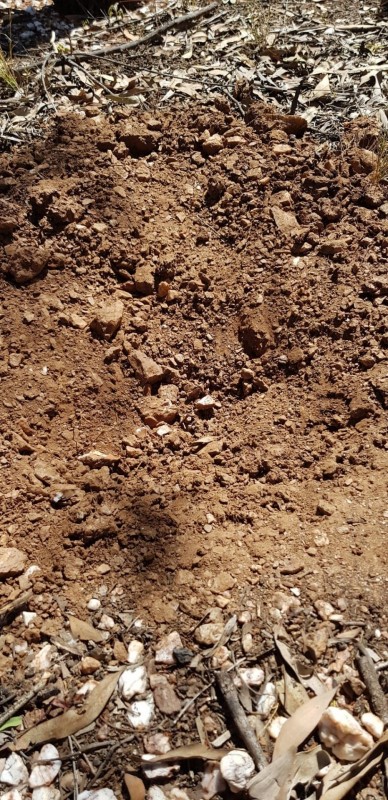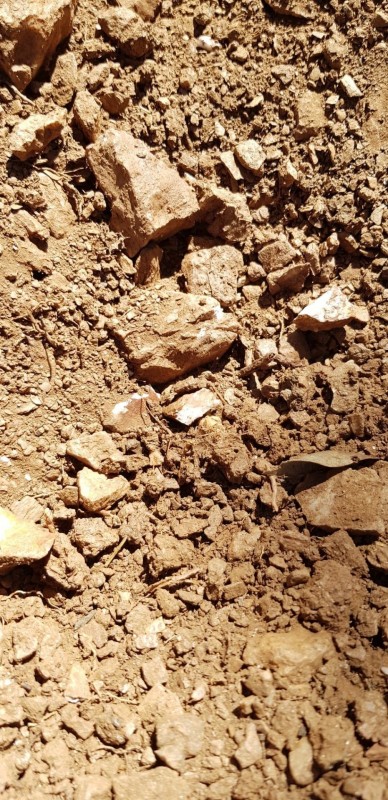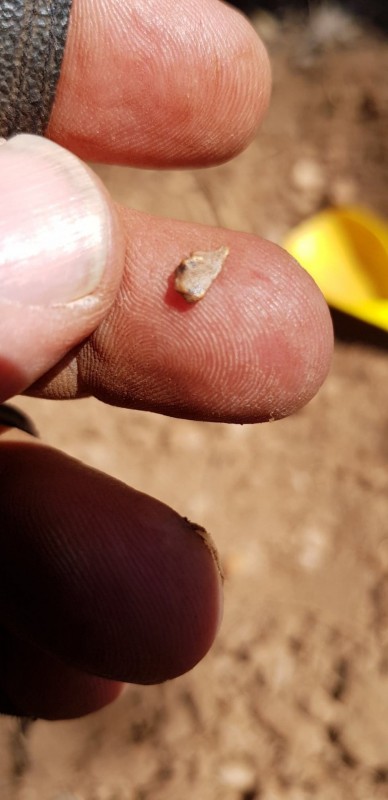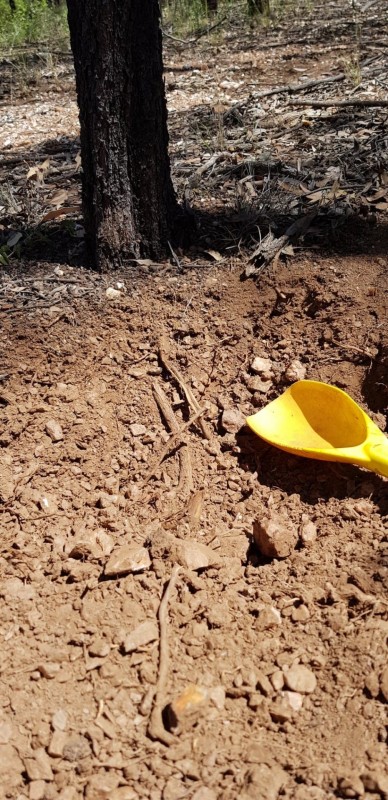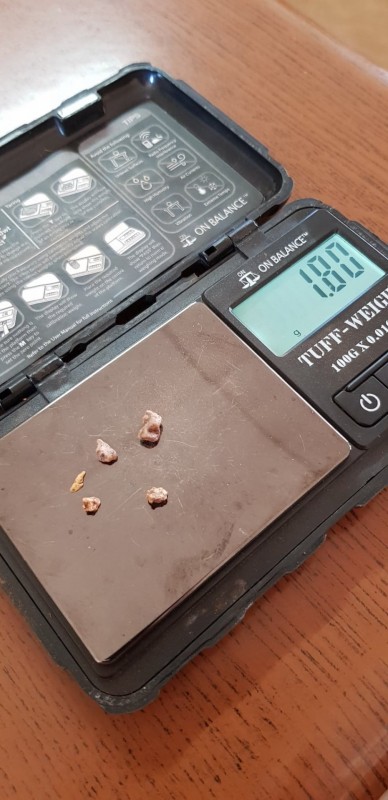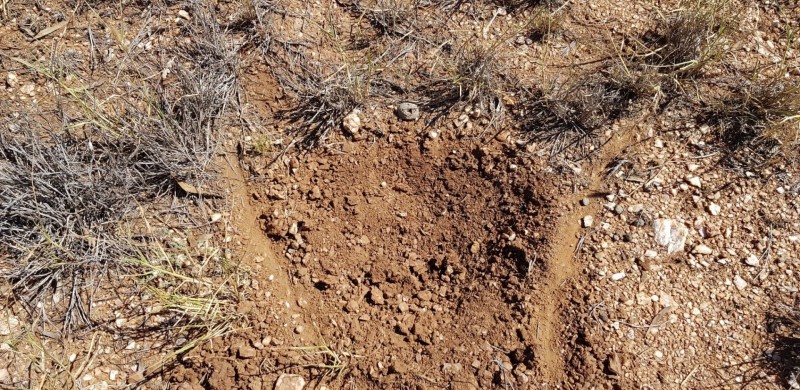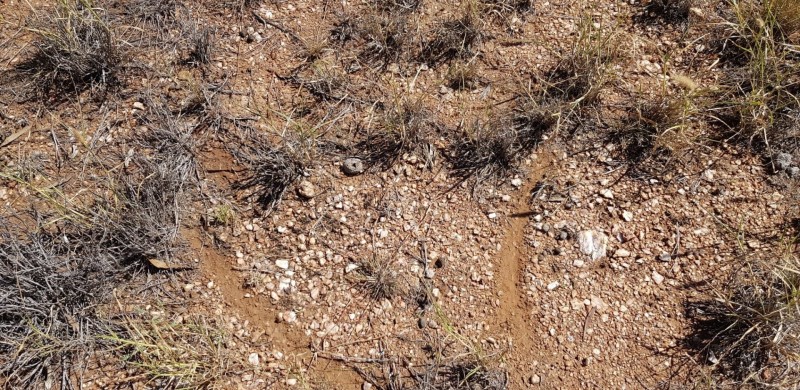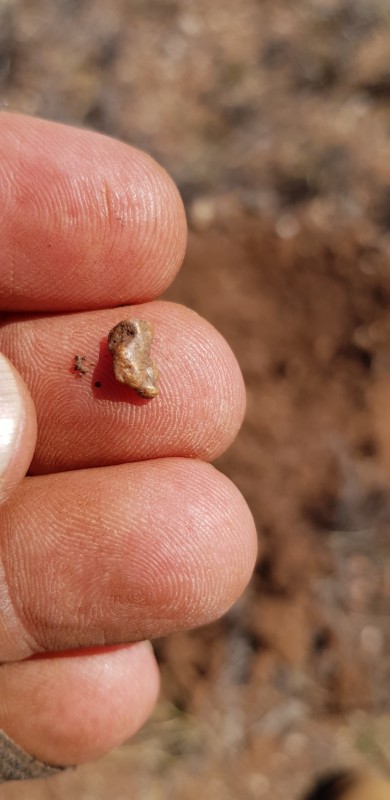-
Posts
1,084 -
Joined
-
Last visited
-
Days Won
35
Content Type
Forums
Detector Prospector Home
Detector Database
Downloads
Everything posted by Jonathan Porter
-
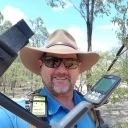
Jp’s Audio Visual Gold Thread
Jonathan Porter replied to Jonathan Porter's topic in Detector Prospector Forum
What’s actually happening, from a scientific point of view, is as you sweep you are hearing ‘something’, that something is enough for you to continue passing the coil over the zone trying to get the target signal to manifest, incrementally without realising it you minutely adjust and refine the sweep speed, the range of motion (two very different things), centering of the coil relative to the potential target and finally gradually changing the height of the coil relative to the target and bingo the signal pops out of the ether. This sub-conscience incremental adjustment is a big part of the whole gamut of visual, tactile and audio sensory input associated with metal detecting. Sometimes the sweet spot is so tight that you ‘pop’ the target only every so often as you pass the coil in through the epicentre of the target zone, this happens a lot in saturable ground as the target signal can get blended in with saturation noise so you only have a few millimetres to play with between the saturation signal affecting the threshold and loudest target signal point, this is one of the reasons why I am not a fan of coils that saturate badly!! A trick to try, when the saturation signal is messing with proximity to ground, is to scrape a wide area over the range of motion target zone because saturable magnetic particles tend to concentrate in the surface soils, scraping them away can give you a few millimetres more room to play with allowing the coil to almost couple to the ground. This method is effective on small shallow targets especially but also beneficial on the larger deep gold that does not increase very much in signal, in fact the lack of signal increase when I clear the saturable materials always brings a smile to my dial because deeper often means bigger. JP -

Jp’s Audio Visual Gold Thread
Jonathan Porter replied to Jonathan Porter's topic in Detector Prospector Forum
That’s exactly how I learned, just remember the correlation between range of motion and sweep speed relative to target signal and try and cobble them all together. I am always on the listen out for a broad repeatable response within the threshold, if you get the range of motion and speed right in context with repeatability the signal jumps out at you. JP -

Jp’s Audio Visual Gold Thread
Jonathan Porter replied to Jonathan Porter's topic in Detector Prospector Forum
Extra Deep is a later sampling timing that has good depth on slow time constant targets. The advantage of the Gold Mode is it’s very effective at removing a LOT of Salt signal and also near to surface ground signal response (both variability and Saturation signals), as such even though the target signal can be reduced a lot compared to other modes the actual deep target signal can stand out from the threshold enough to be recognisable. In effect you are doing a similar thing to using the Motion filter (Audio Smoothing) but in a more refined way because the timing is complete across the target size spectrum relative to what makes it through the delay. The other advantage of using Extra Deep is it has VERY good immunity to microphonic’s when the coil is rolled across hard pebbles and comes into contact with woody sticks, you’d be amazed how much information is lost due to variability in the threshold because of this effect especially in General Difficult. In the Normal modes it’s not noticed so much because the timing is more agressive and agile so the variability in the threshold masks the signals. IMHO the ground Tracking is better in Extra deep than it is in General, there is way less up and down signal in High Yield and Extra deep compared to General, noise from coil raising and lowering has a really big impact on subtle target signals in the General mode especially in Difficult. Finally the range of motion of the coil is extremely important when chasing deep signals especially the ones that barely make it through the delay, it would pay to not sweep over a suspect target too often in any sort of tracking because the resultant remainder Eddie current after the delay will be right on the edge of detection. Interestingly I find the target response of some gold does not always get determined by how much actual weight of gold is present but is more to do with surface area relative to depth, getting the combination right can bring a surprising amount of gold to light, just be aware there will be some targets that are lost to the late sampling. JP -

Jp’s Audio Visual Gold Thread
Jonathan Porter replied to Jonathan Porter's topic in Detector Prospector Forum
Sorry to be a pain, but what is your Volume set to on the bottom right of the Detect page? JP -

Jp’s Audio Visual Gold Thread
Jonathan Porter replied to Jonathan Porter's topic in Detector Prospector Forum
Hi RDD, Are you using Normal or Difficult? Extra deep samples much later than the other two Gold Modes so in Difficult there is a fairly large reduction in signal on fast time constant targets, this is gathered back somewhat in the Normal Ground Type mode. Also it would help if I knew how your setting up your GPZ settings wise and the method of listening to the audio. JP -
Been pretty busy lately organising our business and finalising last minute preparations for the global lockdown associated with current world events. I am so lucky to be able to self isolate in an area where I do not need to travel to go detecting, therefore contact with others is near zero. I encourage readers of this forum to understand the importance of not moving about where there are others present, the risks are too great at this time. Please do not respond to my comments about COVID19 on this thread, I am just explaining my own personal situation and why I‘m able to continue detecting thanks to my location and circumstances and do not want to seem to be encouraging others to take risks if they have to travel any distances to get to a goldfield. I am able to literally step out my front door and go detecting more often than not with my detecting buddy Mia. Here are a few pics of some of the gold I’ve found over the past week between tasks. Gold is a very big part of my usual income and now because our shop is effectively defunct it has become a vital component to our survival strategy. I live where I live for this very reason, having ready access to gold bearing ground was always the main driver for this decision. I am happy to share my finds here so long as it is not seen as rubbing salt into the wounds of those of us who can’t, the primary focus is about sharing something I love with others and I sincerely hope it’s taken that way.😕 Speci found sitting on an old timers pile Yesterday I revisited a favourite old gully where I found 1 1/2 ounces quite a number of years ago, there is always some left behind in scrubby terrain like this. Gold bearing gully Nice solid chunk that made me smile when I weighed it The aim is to ‘try’ and find an ounce a week to keep ourselves afloat during these trying times, any gold coming in is better than nothing! Going detecting and finding nothing is way better for my mental health than being stuck indoors and I hope my sharing goes some way to helping others cope with the magnitude of what is happening to all of us collectively.😔 I will not be mentioning this subject here again as there are plenty of other places for those discussions to take place, but felt I should explain where I‘m coming from in case it is seen the wrong way. JP Yesterdays take
-

Jp’s Audio Visual Gold Thread
Jonathan Porter replied to Jonathan Porter's topic in Detector Prospector Forum
Missed this one sorry...... Channel flipping is when a target is hitting the High/Low and Low/High response all at the same time. The GPZ does it a lot especially on solid small nuggets at depth. The audio can have a slight amount of it present in certain ground types, usually saturable ground or salty ground (quite often its a combination of the two). Channel flipping is also called a “confused signal” when it happens on a target. There are varying degrees of channel flipping, it can happen in one direction of the swing only, it can happen when the coil is held further away, one channel can be more dominant that another and can even swap about as the coil is moved in relation to the target. JP -

What Is Equivalent Of Recovery Speed In The Zed?
Jonathan Porter replied to mn90403's topic in Detector Prospector Forum
You also need to take into consideration the nature of a DOD design coil, they are much slower than a DD coil for instance. This is why I always encourage users to maintain good coil control and even more importantly find the correct range of motion relative to the target. The GPZ is built for depth pure and simple but requires an understanding of its nature to take full advantage of the tech, slow and controlled is the best approach with the GPZ. With the NOX in Prospect mode I find a recovery of 4 to be about on the money any faster and you lose too much depth. If the salt signal is bad you can easily tell its presence by ground balancing with a pumping up and down motion, if the detector won’t settle using the pumping method then salt is present, you can leave the recovery as is and just sweep side to side when ground balancing or speed the recovery speed up to quieten it down during the coil pump method. JP -

Jp’s Audio Visual Gold Thread
Jonathan Porter replied to Jonathan Porter's topic in Detector Prospector Forum
The B audio is the best for sure, that Low/High response is what I’m most keyed to listen for. JP -

What Is Equivalent Of Recovery Speed In The Zed?
Jonathan Porter replied to mn90403's topic in Detector Prospector Forum
The problem with speeding up the Motion filter on a gold nugget machine is it kills depth and makes the threshold a lot more jittery to listen to. It helps smooth out salt signals but so does slowing your sweep speed. The GPZ Motion Filter at Ground Smoothing OFF is set to the equivalent to Very Slow on a GPX 5000. JP -

X Coils In Gb, Scrounging For Missed Nugs
Jonathan Porter replied to jasong's topic in Detector Prospector Forum
Absolute stirling post, upfront and honest, made me want to be out there doing it too. You guys might have a lot of competition on the gold grounds but you sure make up for it in pure scenic delight, I could easily fall totally in love with that landscape. It makes me treasure the isolation and vast amounts of gold areas we have here in Australia, I can literally go to some areas and not see ONE person all season and come back years later and still see no evidence of anyone ever having been there. There are still places in Australia that are hundreds of kilometres from the nearest track, I say track because the track is just that a goat track that has never seen the bite of a dozers blade. Thanks for sharing Jason JP -
Thursday was an experimental day going back over an area I worked with my son over a year ago, when you work with someone there is a tendency to crowd each other out a bit when the gold starts to come out. Distance is necessary because of cross talk so in fairness to each other you tend to wander into the hot spot then wander out again to give the other operator a chance to ping a few bits as well. Because you can always come back the thought of missing a few due to a bit of crowding is not an issue. This time I was able to just cruise around the hot spots and go about things systematically taking my time. The old boys have gully raked this spot so there are piles of stones thrown up onto the high banks, working these banks is hard work due to the angle of the slope and the annoyance of a bit of EMI getting into proceedings from a high Voltage power line some distance away. This just means an extra bit of threshold warble at times requiring a bit more concentration as the coil is tilted out of flat plain. Working my way through the zone produced a few tiny bits that had been missed then I got a nice low/high response on the high bank which required a bit of huffing and puffing and my detector going off on a little excursion of its own rolling down the steep slope. You can see the thrown out stones in the top of the pic You can see the ground is extremely oxidised, this is due to weathering and the high iron content of the country rock. Next pic is of the country rock that has had all the oxidised layer eroded away leaving the un-oxidised bedrock layer exposed. It looks very similar the Yavapai schists I saw when detecting Arizona with Chris Gholson many years ago. This is what Arizona would look like if it had had the same amount of surface weathering Australia has had! This type of compressed Meta-basalts has quite a coarse crystal structure so is really bad for dam building because water flows/leaks through it really easily, on the way it collects all the calcites and deposits them further downslope or within the soil profile (similar to Caliche in the US). Once I’d gone over the obvious spots and pinged a few bits it was time to go for a meander. In situations like this you tend to become exposed to a lot of trash, in my case the area has been habited since the 1860’s both by miners but also timber cutters and cattlemen. Horseshoe nails and bullets became the norm and because a lot of them are caught up under the grass roots it becomes a real chore to dig them out. With this in mind I went into super choosy mode and only dug the best sounding signals and targeted quartz wash exposed areas in the hopes of pinging a little nugget to then force a slow down and more concentrated detecting to try and extend on any gold being found. Huge BIF dyke indicating the fault line Near the end of the session I came across some really nice quartz wash in a bare area with pieces of ironstone mixed in and pinged a tiny little nugget for my troubles. Careful detecting brought out a few more bits then a nicer piece to finish off the morning. I will head back here at a later date and go over it more throughly. JP Last few bits for the day
-

X Coils In Gb, Scrounging For Missed Nugs
Jonathan Porter replied to jasong's topic in Detector Prospector Forum
That type of porous gold is extremely fast time constant, so by the time your GPZ is sampling there’s barely any signal left. High Yield is the best option on the GPZ due to its higher freq behaviour (a little like how higher and lower freq work on VLFs). Your post reminds of the drizzly days in West Australia when we would camp and work in an area for 3 months straight, coming back on the quad to the wife and kids was always the highlight of my day especially when I had some gold to show off. Relying on the gold I found to support my family made for an extra layer of rawness that makes the memories so much more vibrant over time. Thanks for the great post, hats off to you for actually doing it and making the time and effort to share.😎 JP -

Jp’s Audio Visual Gold Thread
Jonathan Porter replied to Jonathan Porter's topic in Detector Prospector Forum
Here’s a video I did yesterday of a GPZ7000 being Ferrite balanced correctly with a GPZ14 coil. You will notice the detector sounds ground balanced when pumped and waved over the ground nearby yet makes a signal over the Ferrite until Quick-Trak is triggered. If a coil continues making a signal on the Ferrite it will also generate noise associated with any X signal in the ground adding to general ground noise which will degrade performance. JP -
In essence what your saying is your a prospector and not essentially focusing on being a detector operator. People would be horrified if they saw how I detect when I’m out “prospecting” as it is a totally different approach. Time is the most valuable commodity and there is no time to dilly dally, leaving a few nuggets in the ground is OK, they are fuel money for later excursions.😜😇 From a PC OCD perspective I just cannot bring myself to use any sort of filtering when the GPZ is so learnable/usable with the Noise floor at its lowest point, I start with Zero Audio Smoothing and go from there, it is immutable AFAIC. Because you are running such high sensitivity levels you're forced to lower your Threshold. I presume your using headphones? Or is it just the WM12? If headphones 12 is WAY high and could be the cause of the instability you are describing. High Yield has an inordinately high amount of volume in its own right, this is why people who are able to use Normal struggle so much when they go to Difficult, because it sounds so muted and strangled unless the ground signal is extremely bad. I have areas in Australia where I have used Normal constantly, last year was one of those times and I pulled many many ounces taking full advantage of the High Yield Normal timings. I was also able to take full advantage of the 17” round X coil as well which kicked proverbial😜 thanks to its very good near to coil sensitivity and of course extra depth due to size. In the more variable areas I just lowered the TARGET Volume to compensate for ground signal variability that started to dominate the threshold, you can easily do this in High Yield as the timing has oodles of grunt. All you have to do is subdue the “in your face” twitchyness by controlling the most powerful control which is the Target Volume (Volume control on the Detect page). This is why I use a booster because it gives you more control over volume without having to resort to using the Target Volume which is too coarse! As a suggestion try using these with a quality booster such as a B&Z or Steelphase. The audio in them is quiet so a booster is required, but the noise cancelling is incredible and allows you to hush out a lot of noise pollution whilst still feeling connected with the world. Everything I‘m saying is suggestions only, I of course will be experimenting with the way your running your machine. However in my experience ramping everything up then being forced to then dumb a lot of it down through filtering is counterintuitive. If the busyness of the machine is annoying then just lower the Target volume till it is subdued, so long as you can hear a smooth stable threshold you will hear targets. Applying Audio Smoothing is telling the detector you do not want to hear anything below a certain point, no amount of sensitivity increase will get it back again once its filtered out. It can take quite a long time for your ears to readjust to a lower volume/sensitivity, your brain does a heck of a lot of filtering on its own. Your old patch is a brilliant opportunity to experiment now that you’ve gone over it in your preferred style and removed all the targets, dependant on your time allowance of course. If you had time it would be a good place to spend and hour or two going over it again experimenting with the Target Volume till you had a clean audio that did not punch up all the variable responses but allowed “Good” metal targets to stand out. In Normal I am ruthless, a target signal needs to have good “lead in” and “tail out” especially the deeper ones. “Lead In” and “Tail Out” are hugely affected by filtering. Lastly I mean no offence and sorry to harp on. I understand where your coming from and the way you like to run your machine and how it compliments your detecting style, clearly you’ve spent a lot of time experimenting to come up with what works for you. JP
-
The reason you are having to use Auto over Semi-Auto is the rocks are high in X signal, because the coil does not balance X signal properly you have to rely on the combination of G and X balance tracking associated with the Auto mode. Just as a suggestion if you decide to go down this path again, try running your threshold on 27, Audio Smoothing OFF, Volume 8 and lower, Sensitivity on 9 and let the detector do the work. I feel the way you had the detector set up your enhancing natural variation into the target space which is very fatiguing especially in High Yield Normal. In essence your usual settings were using Smoothing as a filter to control the increased audio response that higher sensitivity levels create, lowering the threshold below 27 is tending to suggest you are using it as a volume control measure because it sounds too dominant at higher levels, problem is the threshold gets very stop start below 27 surging constantly. Instead when using the settings I’m suggesting keep lowering the Detect page Volume to control intrusive non-even responses when using the lower sensitivity and higher threshold of 27. High Yield Normal has oodles of sensitivity even with sensitivity set to 9. Do not be afraid to lower the Volume right down to 4 or 5. JP
-

X Coils In Gb, Scrounging For Missed Nugs
Jonathan Porter replied to jasong's topic in Detector Prospector Forum
The quality of posts on this forum has skyrocketed lately, great read Jasong.😎 I agree about the elliptical, its best for more open areas where coverage is paramount compared to tighter spots. JP -

Jp’s Audio Visual Gold Thread
Jonathan Porter replied to Jonathan Porter's topic in Detector Prospector Forum
I’ve missed something here obviously. As was mentioned in the threads bio I would prefer others not putting up photo or video material etc on these threads but you are more than welcome to have a discussion about any of the subject matter enclosed. I sincerely want to avoid conflict and keep the posts informative and friendly. However to be fair I have used an X coil as a means of demonstrating various behaviours that are detrimental to GPZ use which Minelab went to great pains to design out during development, poor Ferrite balance and Saturation noise are detrimental to working in my areas. In the interests of fairness I intend to film these again using a GPZ14 coil in the same locations to show the differences. This was not an attempt to discredit or create argument but to clarify comments I’ve made in the past on the subject. Showing what these detrimental behaviours actually sound and look like is educational I feel. If Phrunt wants to start a new thread with his video I’m more than happy to answer any questions as best I can so long as it remains amicable, for my part I will do my best to keep it that way. JP -

Jp’s Audio Visual Gold Thread
Jonathan Porter replied to Jonathan Porter's topic in Detector Prospector Forum
Hi Gerry, I never touch my threshold relative to Audio Smoothing, 27 on the GPZ compliments Audio Smoothing OFF perfectly. However what I do adjust a LOT is the Volume on my Booster. Sound pollution is a real problem when detecting whether you use speakers or headphones so you NEED to be able to hear and be connected with your threshold at ALL times. The balancing point is trying to elevate the Threshold Volume (different to Threshold level) so that slight variations stand out without causing distortion or worse without making the Threshold TOO dominant and then killing sensitivity to pitch change variation. It’s a complicated thing to get right and of course we are all different in the way we listen. Threshold too low causes the audio to surge killing sensitivity through the volume variations (a little like the Audio Smoothing filter), too high and the threshold loudness kills sensitivity by becoming too dominant relative to pitch/volume changes. Lately I’ve been experimenting with the Volume control on the Detect page to introduce a bit more thump without blowing overall stability and smoothness, but you have to be careful because each change above 8 is like increasing the Sensitivity by two. In my case I rarely go above 10 unless the wind is howling and I have no choice but to increase or quit. The Volume Control on the Detect page is very coarse between numbers so you have to be careful to not overdo it, you also have to realise that when you get USED to a high volume it takes a long time for your ears to re-adjust back to lower volumes again, this then has the effect of making you feel you are deaf and might be missing gold. IMHO temperature has more to do with personal comfort than it affecting the actual ground itself (this is different to moisture and moisture layers BTW, a whole different subject), however the earth does go through stages during the day night cycle that waxes and wains the natural sounds, night time is much quieter because usually the wind dies down, and all the critters go to bed. It is also usually more comfortable temperature wise so an operator in warm climes will feel less heat stressed (most detecting is done in Desert country after all). Also as the earth rotates from Night to day there is a natural warming of the planet from Dawn on which heats up the atmosphere above causing natural instability in air, so Sferic noise and general EMI will increase and combine with the general noise thats associated with a planet that is coming to life again after the dark. I experience this most days getting up before dawn when it is calm and quiet hearing the gradual sounds of life gathering momentum. IMHO adjust your threshold at the quietest part of the day then use your volume controls to maintain your ability to hear it as the noise levels of the environment increase or decrease. There is some evidence that Sferic noise increases just as the sun sets then goes quiet but TBH most of it is linked with personal comfort based around ambient temperature relative to your core body temperature and overall atmospheric instability. IN the case of the GPZ thanks to its amazing electronics and our ability to now tap right into the VERY noise floor of the machine you are able to listen to the variability of the magnetic materials associated with a weathered deposit. I can actually hear the chattering in the threshold (described recently as “bitching” ), the detector sounds slightly unsettled and annoying to an untrained ear, this noise is not linked with general localised mineralisation chatter but ground noise can mask it to some extent so is not noticed so much in most areas. When you are right on top of a gold shedding location this magnetic chatter will be at its strongest and can be quite distracting, as you work away from the zone the chatter will become diluted as the weathered materials of rock types that contact with the gold mineralisation zone blend in with the magnetic shed material, in some tight spots there will be concentrations of this material that can sound noisy but these are slightly different to the gold shed zone, this magnetic response is very much different to saturation noise but is associated as well. I use this method of listening to the noise floor chatter as a prospecting tool in remote green fields locations, I have often found gold because I hung around an area and walked it more thoroughly even though they ground did not look promising. This effect can be very subtle and is once again a BIG reason why I use conservative settings with specific Volumes so I do not drown out or kill off this vital variability. In a know patch of ground it can become annoying but in unknown ground it is a VERY BIG clue to the potential of gold being present. JP -
Today was a bit of a late start as I had a few things that I’d been putting off for too long, the reward getting the job done was a few hours detecting which was fun. I wandered around a pretty large area this morning, going back over my “Sun baker” Patch and then working out from there. As I worked my way away from the main run I heard a channel flip confused signal that was subtle but present. So I pulled out the phone and captured the audio to share with others here. You will notice I’ve scraped some lines either side of the target to indicate the width of the response relative to coil motion, any narrower than this and these deeper targets become lost in the general busyness of the threshold because they are not being given a chance to develop properly. Pics of ground with mark lines before digging and after for comparison. The rest of the mornings gold found As always it was fun to be out and about and nice to be able to share my experiences with others. JP
-

Jp’s Audio Visual Gold Thread
Jonathan Porter replied to Jonathan Porter's topic in Detector Prospector Forum
I often get asked what Saturation signal actually is, here is a video of a coil saturating badly on mineralised ground. With good coil control you can work places like this but it takes a lot of effort. JP -

Jp’s Audio Visual Gold Thread
Jonathan Porter replied to Jonathan Porter's topic in Detector Prospector Forum
It is better if the Ferrite is flat, but in this instance it didn't matter because the coil was reacting so aggressively towards the ferrite anyway and could not be balanced out. -

Jp’s Audio Visual Gold Thread
Jonathan Porter replied to Jonathan Porter's topic in Detector Prospector Forum
This is a video I’ve done to demonstrate the correct height you need to swing the coil over the ferrite when performing a ferrite balance. Looking from above it is very deceptive of the actual height the coil is in relation to the ferrite. The key is to get the coil in close but not scrape or rub the Ferrite. Some residual signal is OK but a large noise isn’t especially in high X ground. Settings: Gold Mode: High Yield Ground Type Mode: Difficult Sensitivity: 9 Audio Smoothing: OFF Threshold: 27 Ground Balance: Semi Auto Quick-Trak: held in when swinging over Ferrite Volume: 10 (was using the WM12 speaker for filming) Threshold Pitch: 40 -

Jp’s Audio Visual Gold Thread
Jonathan Porter replied to Jonathan Porter's topic in Detector Prospector Forum
OK, so you need to look to your settings. The GPZ is a very forgiving metal detector especially in highly mineralised dirt. The things the GPZ reacts to is saturation signal and salt. If you couple your coil to the ground and pull it away (assuming it it ground balanced) and a signal sounds off that is saturation. If you lift the coil away from the ground and continue it on up to above your shoulders and a signal is heard that is salt. The way to combat either of those is through sensitivity, and the modes. If either of those is affecting your ability to discern a target you really need to look to your settings and change accordingly. BTW be careful of the Volume control, it is really powerful if used incorrectly. I have some footage hereabouts of the GPZ saturating quite badly in really variable dirt, I’ll throw it up to YouTube when I get a chance. JP

